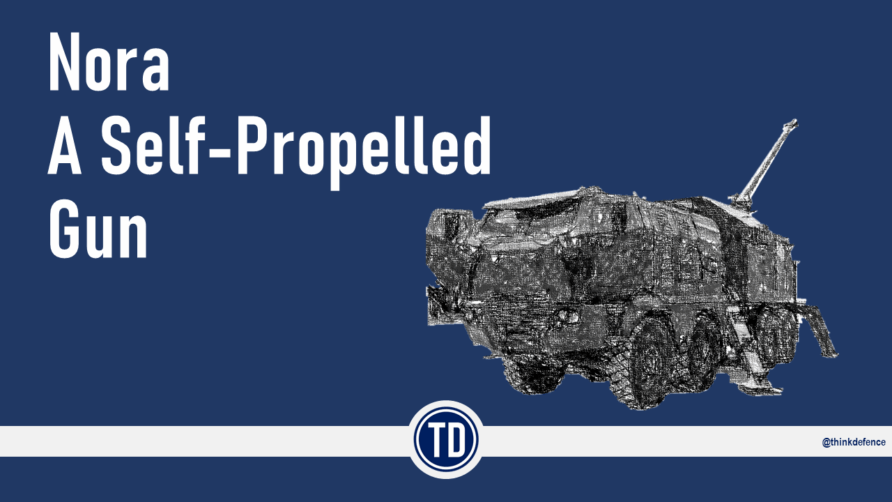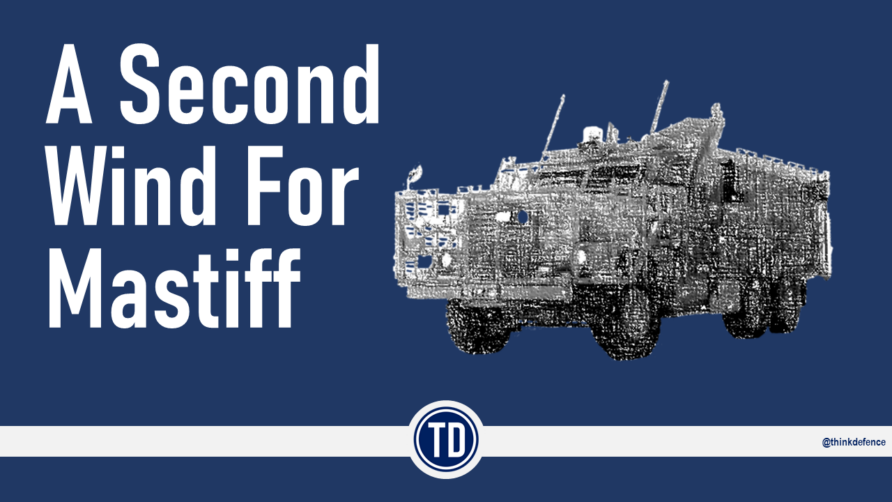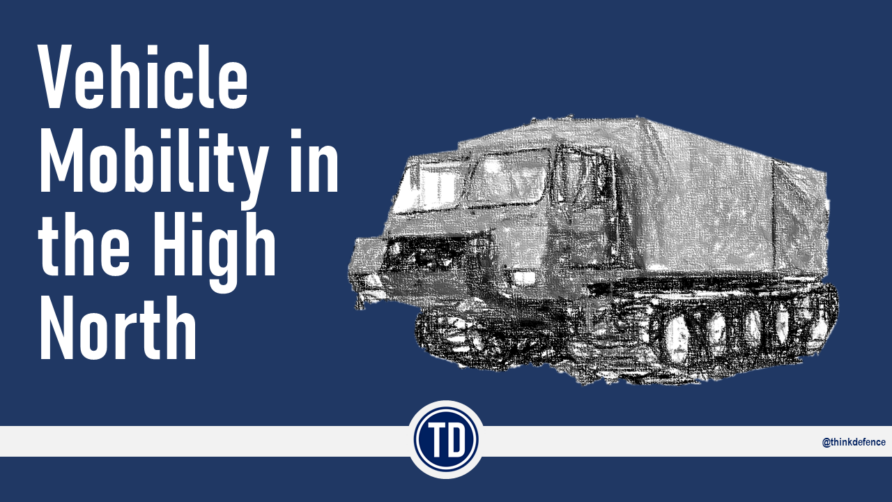Comparing one vehicle to another is complicated.
The Problems with Comparisons
One vehicle manufacturer may use different terminology to describe kerb weight, others may not list towing capacity. Payload is also subject to variation in definitions, manufacturers may include the weight of the crew, or not.
Some will include the weight of jacks, spare wheels and other equipment in the basic vehicle weight, others not.
Civilian vehicles will not have DEFSTANs-compliant tie-down points, weapon racks, or other fittings that add weight
Payload comparisons must take this into account.
On the other side, the weight of equipment included in the vehicle’s base weight such as tipping bodies and crew comfort aids might also be removed when used in a military context.
For vehicles with internal combustion engines, their range can be extended by simply carrying more fuel, for battery vehicles, more batteries. Energy density and weight will normally favour internal combustion engines, and refuelling is always going to be faster than recharging.
The range of the battery may be very dependent on temperature and usage profile.
Range comparisons will in most cases be relatively meaningless because of this.
Getting in and out of trouble in the smallest amount of time possible has value in a defence context, speed is important, but for agricultural, municipal and forestry markets, it will have a lower priority than load-carrying ability and reliability.
This will be reflected in available vehicle designs.
Maximum speeds are quoted, but they are equally meaningless unless terrain is considered. Real-world speed across challenging terrain is an equaliser, and where torque and grip count for more than speed on a road.
Any vehicle comparisons must always come with a ‘health warning’.
But let’s do them anyway.
The Kerb Weight-to-Payload Ratio
A simple division of the two weights as described by the manufacturer.
The only ones with a three-to-one ratio or better are the Di Blasio R7 folding scooter and the Rokon Trailbreaker with a sidecar.
Those two are closely followed by typical e-bikes and then other motorcycles, mostly above two-to-one.
This should be no surprise, but it is interesting, nonetheless, two wheels, an engine and a seat is the most efficient combination for moving a single person with only light stores.
Between a ratio of 1.5 and 1.9 to 1 are a small group, the AVT Minerva, Caron and Goldoni agricultural carriers, and the compact forestry forwarders.
They do this by sacrificing speed and concentrating on torque. Some of these vehicles can also tow a heavy trailer, the Caron AR630, for example, can carry 3 tonnes and tow 5, slowly.
Also in this group is the RANG-R, and it can tow a good weight as well.
Of the more military-oriented vehicles, the Unac Rider, Bale Defence RTV and Flyer 60 are all at 0.9 to 1. The Polaris MRZR languishes at the bottom of this league table, whilst the MRZR Alpha models at least double their ratios, they are built to carry greater payloads.
Of the uncrewed group, the Aardvark RANG-R and AVT Trident 35 are joint first, at 1.5 to 1, with the IDV Viking as a runner-up with less than half that ratio. In the relegation zone, Mission Master SP and Themis.
At 0.9 to 1, the Mudd-Ox XL and Supacat ATMP are the skid-steer group runners-up, with the Supacat ATMP having excellent towing capacity, but the three AVT models lead at between 1.5 and 1.8 to 1.
Perhaps surprisingly, the pickup-derived vehicles are not as high as one might expect, with the Bonetti FX100 and Hako Multicar leaders in the medium-wheeled 4×4 category.
Of the tracked vehicles, none are above one-to-one, with the Softrak 75 and Yanmar CR30 in the top two positions.
Excluded from these comparisons are the tractors, they can weigh a great deal and carry nothing but the operator, they can, however, tow a very heavy trailer and have a PTO or hydraulic pump that allows that trailer to be driven.
Just to stress again, these are crude one-to-one comparisons so don’t read too much into them, you cannot compare an MRZR to a Yanmar-tracked tipper for most practical defence applications.
A Flight of Four Helicopters
Rather than comparing one vehicle against the other, a more sensible approach would be to compare vehicle combinations against a fixed number of helicopters.
The baseline is no vehicles, and four helicopters worth of Marines, Paras, or Rangers is not to be underestimated.
Although not strictly a constraining factor, using multiples of 12 personnel might also make sense given recent trends in organisational design.
There are many situations where Chinook and Merlin would be working together but for the sake of simplicity and comparisons here, assume they aren’t.
Each of the scenarios below will include.
- Baseline; no vehicles, just people
- Light and Fast; focus on speed and minimal stores.
- Mixed; a balanced force that has a mixture of personnel and stores.
- Poor Terrain; no roads, mud, and snow
- Uncrewed only; the future?
An assumption for all scenarios is that unless the vehicle can be carried down the centreline or is less than 1.6m wide, personnel will travel separately to the vehicles. If a vehicle is short, personnel may travel in the ‘void’ if they have access to the side doors.
A second assumption is that any vehicle combination should provide all personnel with a seat. An alternative option could be that a vehicle is used to carry personal equipment and stores, and the personnel march separately. This is not unreasonable as it allows those personnel to march unencumbered and maximises personnel numbers, but not used in this series.
Off to Belgium!
Before reading on, would you mind if I brought this to your attention?
Think Defence is a hobby, a serious hobby, but a hobby nonetheless.
I want to avoid charging for content, but hosting fees, software subscriptions and other services add up, so to help me keep the show on the road, I ask that you support the site in any way you can. It is hugely appreciated.
Advertising
You might see Google adverts depending on where you are on the site, please click one if it interests you. I know they can be annoying, but they are the one thing that returns the most.
Make a Donation
Donations can be made at a third-party site called Ko_fi.

Think Defence Merch
Everything from a Brimstone sticker to a Bailey Bridge duvet cover, pop over to the Think Defence Merchandise Store at Red Bubble.
Some might be marked as ‘mature content’ because it is a firearm!
Affiliate Links
Amazon and the occasional product link might appear in the content, you know the drill, I get a small cut if you go on to make a purchase
A Flight of Four Merlin Helicopters
Baseline
The baseline of no vehicles is four lots of 24 personnel, 96 in total, or eight 12-person teams. This package would be foot-bound and unable to carry large amounts of support weapons and sustainment stores.
Light and Fast
Assuming reasonably good terrain, any one of the folding e-bikes or the Di Blasio R7 could potentially be carried down the centreline. This would provide the baseline force with the ability to move approximately 100 km plus in three or four hours.
They would be at very light scales in this configuration, the folding bikes in their carrying bags would effectively displace their Bergen.
If the flight of four helicopters were split, with one used for a group of twenty-four personnel only and the other three used for transport, they could carry between twelve and eighteen e-bikes or motorcycles. Some of those would have to carry a pillion-passenger.
One of the more intriguing options for this scenario is the Rokon and sidecar combination, mostly because the sidecar can be carried separately (stacked on top) and quickly attached when on the ground. The sidecar can be used to carry an extra person or additional stores, but it would not take up precious floor space in transport.
In the load diagrams, I showed six per Merlin, but if space for another two could be found by stacking or closer stowage, and the sidecar used for an additional seat, it would allow two helicopters to be used for personnel. Forty-eight personnel would be in two helicopters and the other two, chock-full of Rokon.
Forty-eight personnel with 30-40 kg of stores each, covering a distance of 100 km plus in three or four hours.
Mixed
ATVs and trailers would be the most obvious choice because we have them in service and are compact.
Two per Merlin would allow enough space for the two operators, the four helicopters would yield a total of eight personnel and minimal stores. With a trailer, this would go down to one per helicopter and decrease the personnel number to four, but with four to five hundred kg of stores.
This is quite a poor return for four helicopters.
Using a three-axle ATV like the Can-Am or Reek would be one per helicopter, but it increases the trailer capacity whilst still allowing the two personnel to sit inside. The four helicopters would support eight personnel, and between the load bed and trailer, over 500 kg of stores.
The Fresia F-18 has a surprisingly strong showing in the ATV class, with sixteen seats and 3.2 tonnes of stores across the four helicopters. Their small width allows the seats on the side to be fully used, and the high payload per vehicle soon mounts up. They are much slower than conventional ATVs.
The relatively short length of the Bale RTV, Unac Rider and Kawasaki Mule could allow two per Merlin. It is assumed that for these two, one helicopter would be used for personnel, and the other three for vehicles. These would allow for four seats per helicopter (accepting that some could add additional seats on the load bed) but leave little room for trailers.
Across the four helicopters, six vehicles, twelve seats and the third helicopter with just personnel half loaded.
This is where four-seat vehicles like the Polaris MRZR D4 and MRZR Alpha D4 make more sense because they return the same number of seats, have enough space for a trailer, and half the number of engines.
The MRZR Alpha D4 is attractive because of its much-improved load-carrying capacity, whilst retaining the UTV width. The four helicopters would provide three vehicles, twelve seats, and 2.7 tonnes of stores, with space for three trailers.
Flyer 60 would be a similar configuration, but have greater load carry capacity and offer protection options.
Keeping under 1.6m wide, the municipal and agricultural vehicles tend to be slower and not big on seating, but if the requirement were ‘stores heavy’ they would be invaluable.
The king of the load carriers is the Caron AR630. In a stores-only configuration, all four helicopters would carry one to their maximum payload, four people and over twelve tonnes of stores.
The Grillo and Comaca would require engineering work to replace the cab with a folding ROPS but provide seating for two per vehicle, eight seats and seven tonnes of stores, and enough room for a trailer.
If the jump seat option in the Goldoni Transcar was acceptable, four could be carried for a total of twelve personnel and nine tonnes of stores.
Going above 1.6m width means that in most cases, exit routes and loading and unloading might become an issue.
The Polaris Dagor, HUT-P, Falcata, and pickup trucks such as the Hi lux Double Cab and Babcock GLV would technically fit, but there would be no room for personnel to be carried alongside the vehicle or in the void space and operability is questionable.
One of the four helicopters would have just personnel and the other three vehicles, the first one landing personnel to provide landing zone security and help with offloading, potentially at another site nearby.
Whilst vehicles like the HUT-P, Dagor and Falcata might provide some advantages, the difference between them and pickup or pickup-derived vehicles might be considered not enough to warrant a small purchase of a unique vehicle. Depending on the trade between load space and seating, something like the Babcock GLV or Toyota Hi lux could provide three vehicles, between twenty-four seats, or twelve seats and three tonnes of stores.
This is the same as the Polaris MRZR Alpha combination described above, except the vehicles would be harder to load and unload.
Focussing on payload again, using a vehicle like the Haco Multicar or Bonetti FX100 provides four vehicles, eight seats and ten to twelve tonnes of stores. Both vehicles would require engineering work to replace the cab with a folding ROPS and would, like the pickups, be more challenging to load and unload. With the smaller personnel numbers, the crew could be in the same helicopter as the vehicle.
These two are faster than the agricultural carriers, but the payload is not significantly different, and the Goldoni provides (rudimentary) seating for the full 12-person team.
Poor Terrain
In poor terrain, skid steer or tracked vehicles would enable the necessary mobility.
The shorter ‘skid-steers’ such as the Argo Frontier 700XT and AVT Minerva 6×6 could be loaded two per Merlin, providing six vehicles, twenty-four seats and 1.2 tonnes of stores. These compare favourably with some vehicles in the previous section, but it illustrates the dangers of comparing like for like.
The skid steer vehicles generally make use of bench seating and because they tend to operate at lower speeds, only lap belts are provided. This doesn’t apply universally, but it does show how data sheet comparisons don’t tell the full story.
Their seating space can also be used for stores instead of passengers.
The larger skid steers like the AVT Minerva 4M, Scot Trac 2000R, Argo Conquest, Mudd Ox, Supacat ATMP and Canadensy HAWC are all impressive vehicles, with the Supacat, Scot Trac and AVT all benefitting from UK supply chains and IP.
The AVT Minerva and Supacat ATMP are standouts in performance terms as well, their payload and towing capacity especially. The hydraulic export and amphibious capability of the AVT Minerva would also be very useful across a range of tasks.
These can also be fitted with track tyre kits, as can the side-by-sides.
For use on snow, the two ski-dos provide high speeds and the Alpina Sherpa, has additional seating and excellent towing capacity. Using three Merlin for vehicle transport and the fourth for personnel, the Sherpa would provide fifteen seats and 3.6 tonnes of payload, although some of that payload would be taken up by seats, so twelve personnel is a better fit.
There would be enough space left over in the helicopter for a ski trailer, uplifting personnel or payload carriage significantly.
For mixed terrain, the other tracked vehicles could be used, the Lite Trax providing the same capacity as the Ski Do ORPs, twelve seats and just over a tonne of payload when using three plus one Merlin.
If greater payload were required, the All Track AT20D wins out, 4.8 tonnes, but only six seats. Move to one vehicle in every helicopter, and this rises to eight seats and 6.4 tonnes.
With all these designs, trading seats for payload capacity/space could make it possible to move the numbers one way or the other.
Uncrewed
If a completely uncrewed group were used, it is difficult to compare because if we are just measuring payload, that payload would likely be specialised, sensors or weapons, and for these, absolute capacity may not be a good indicator of performance.
At one each per Merlin, the Rheinmetall Mission Master SP provides the lowest payload at 2.4 tonnes, followed by the IDV Viking at 3.6 tonnes. The two best performers are the Canadensys RAPTOR at 4 tonnes, then the Aardvark RANG-R at 15.4 tonnes.
The RANG-R would also max out the Merlin payload, so not all the 15.4 tonnes would be usable.
The AVT Trident sits between the RANG-R and the rest of the pack, but it is still in development.
A Flight of Four Chinook Helicopters
Chinook doubles the payload of Merlin and has a larger cargo bay, but this does not automatically translate into double Merlin capacities.
Baseline
Seating in Chinook is variable, with many possible overload conditions. For the sake of this article, the assumption is 33 per helicopter, a total of 132 personnel, or 11 twelve-person teams.
Light and Fast
As with Merlin, carry folded e-bikes or scooters down the centre of the helicopter and the baseline numbers are the same, but with extra mobility on firm surfaces.
Cue the Benny Hill music!
With larger motorcycles like the Enduro type, and assuming they would be carried in three of the four helicopters, 18 could be carried. With one person per motorcycle, the personnel number reduces to eighteen, but if riding with pillion passengers is acceptable, this would rise to thirty-six, slightly higher than the thirty-three carried in the fourth helicopter.
Using the same Rokon and sidecar method as with Merlin, using two Chinooks for the motorcycles and two for personnel, the final count would be twenty-two motorcycles and sidecars, providing seating for 66 personnel and their stores, split across the remaining two Chinook in the flight, or slightly rounding down to five twelve-person teams.
Mixed
As with Merlin, quad ATVs and trailers do not scale well with Chinook, with four per helicopter, the total would be 16 vehicles, 16 personnel, and 3.3 tonnes of stores. Furthermore, It is likely that four would not be carried because the fourth would block the side doors.
With three per Chinook, it goes down to 12 vehicles, 12 seats, and 2.5 tonnes of stores, quite a poor offering.
The three-axle ATVs from Reeq and Can-Am would be two per Chinook, 16 seats and 2.5 tonnes of stores.
One of the standouts from the Merlin section was the Fresia F-18 also does well with Chinook. Four could be carried per helicopter, so 16 vehicles, 32 seats, and 6.4 tonnes of stores.
The Gibbs Terraquad would result in 8 vehicles, 16 seats and 4.4 tonnes of stores, and it is amphibious.
With a vehicle like the Bobcat UV34XL, two would fit in a Chinook, but there would be no room at all for personnel seating, resulting in a three-plus-one arrangement. This would result in the four Chinook helicopters being able to carry six vehicles, 36 seats and 3.4 tonnes of stores.
The others in the UTV class, assuming one of the helicopters is used for personnel, except for the shorter models like the MRZR that allow two per helicopter with enough space for 4–6 personnel. The shorter UTVs like the Bale RTV and Unac Rider scale less well with Chinook, much better are the MRZR D4 and MRZR Alpha D4.
Both would provide two vehicles per Chinook, twenty-four seats and 1.4 tonnes of payload for the MRZR and twenty-four seats and 5.4 tonnes of payload for the Alpha, fitting neatly with having two 12-person teams.
The Flyer ups the payload to 9.6 tonnes and provides access to a wide range of variants and payload options.
With a focus on payloads, the Caron AR630 and Goldoni Transcar are outstanding, the former providing eight seats and 26 tonnes of payload, with the latter dropping to 19 tonnes but providing basic seating for twenty-four.
Moving into the 1.6m wide plus category is the same story of marginal gains for specialist vehicles compared to general service vehicles as for Merlin.
These are slightly easier to load and unload than the Merlin, but even specialist vehicles like the Dagor or ISV don’t provide a significant difference from a Hi lux or something like the Babcock GLV.
Poor Terrain
For the skid steers and tracked vehicles, again, the story is similar to Merlin.
The shorter ones can be used to maximise bench seating capacity, but the AVT Minerva and Supacat ATMP have the best mix of seating, payload, and towing capacity, matched to the seating capacity of the fourth Chinook. These
For deep snow, the Alpina Sherpa again seems to offer the best mix, with 30 seats and 5 tonnes.
Trailers — Stores
Many of the vehicles are too long for two in either of the helicopters, but short enough for one to create a decent amount of void space.
This void can in some cases be used by a few personnel, but where bulky stores are required, using a trailer can provide the space.
Vehicle mobility will generally be reduced, it is a trade-off, but one that might be accepted for simple A-B moves.
Some vehicles in the previous posts can tow a significant weight. A group that is between 2.0 tonnes and 3.5 tonnes (aligned with legislation) includes the Supacat ATMP, Scottrac 2000R, AVT Minerva, Bonetti FX100, Hako Multicar and pickup truck-derived vehicles.
The Caron can tow up to 5.6 tonnes, no surprises there then!
A couple of the uncrewed vehicles can also tow a significant weight, the Canadensys RAPTOR at 2 tonnes and the RANG-R at 3.5 tonnes.
Trailer weight will depend on size, construction methods, the number of wheels or tracks, and whether additional features like axle drives are used.
Perhaps the two greatest advantages of trailers are their low cost and the simple fact they can be made to suit exactly the dimensions required.
There is no need to conform to any existing model dimensions, bespoke design is entirely feasible.
Some examples are shown below that assume standard vehicles are used, not single-seat tractor units with no load bed or seating beyond the operator.
Merlin
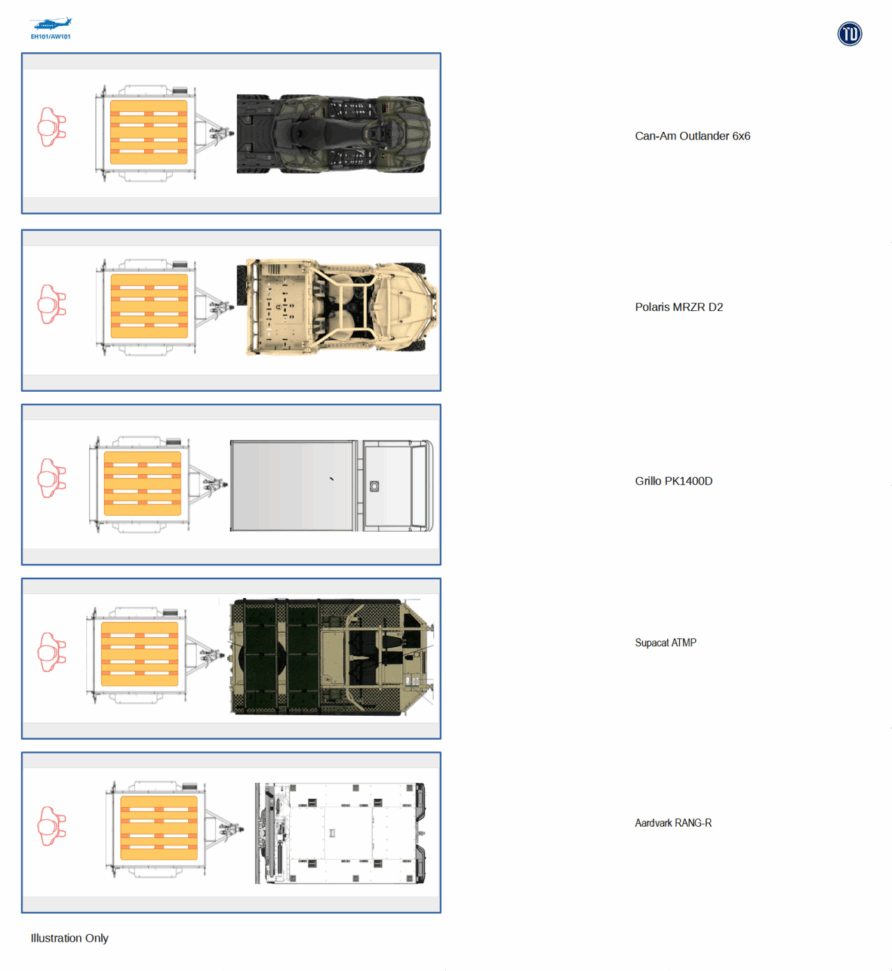
Chinook
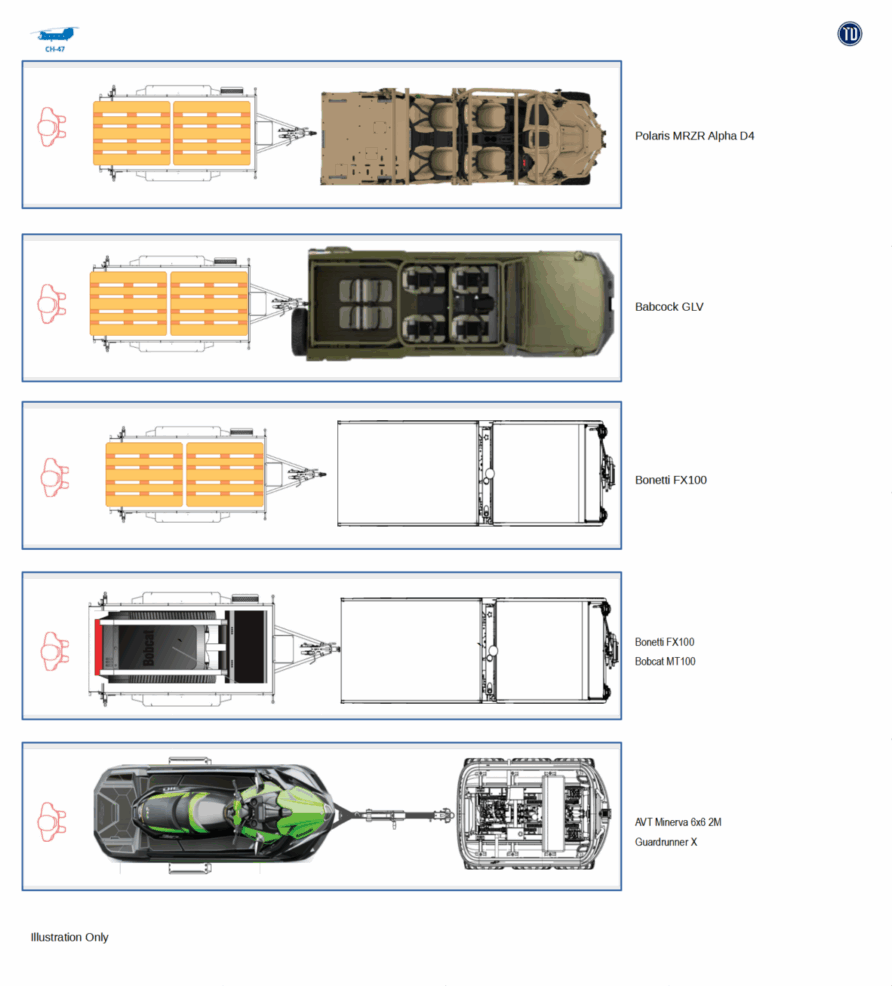
Trailers — People
The image below shows four different vehicles with a personnel trailer. It is still assumed that personnel are carried in the fourth helicopter and the trailer would be completely non-tactical, only used for minimal-risk moves.
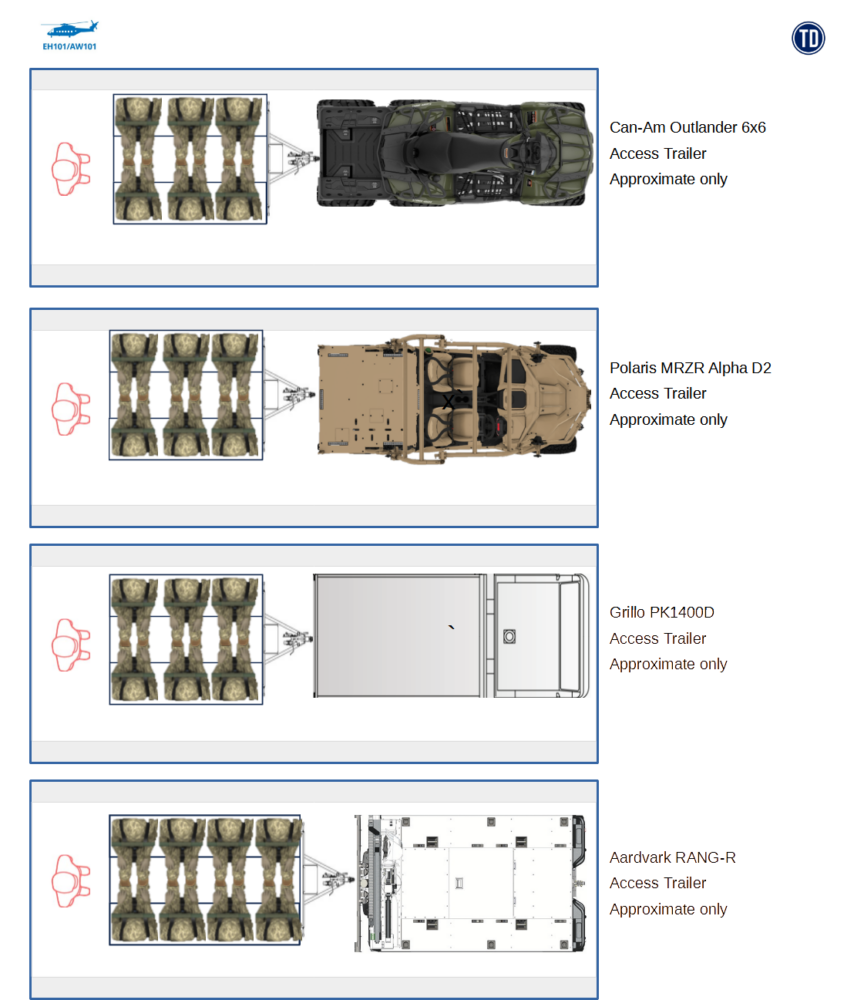
These are four random vehicles from the list.
- Can Outlander: 3 vehicles, 24 seats, 0.9 tonnes of stores.
- Polaris MRZR Alpha D2: 3 vehicles, 24 seats, 1.9 tonnes of stores.
- Grillo PK1400D: 3 vehicles, 24 seats, 5.3 tonnes of stores.
- Aardvark RANG-R: 3 vehicles, 24 seats, 11.55 tonnes of stores.
With the RANG-R, the real-world payload would be slightly lower due to single Merlin limits.
This means the fourth Merlin is used just for personnel.
Taking the same approach with Chinook, also assuming three helicopters for vehicles/trailers and the other for personnel.
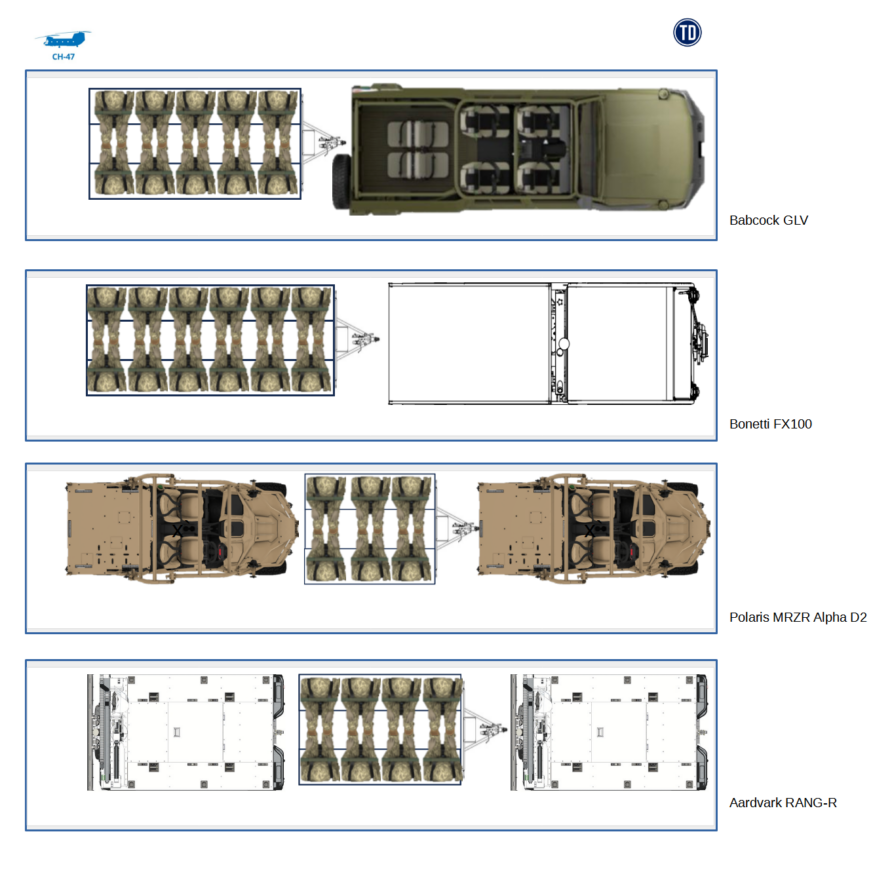
Another four vehicles from the list.
- Babcock GLV: 3 vehicles, 54 seats, minimal space for stores.
- Bonetti FX100: 3 vehicles, 54 seats, 8.4 tonnes of stores.
- Polaris Alpha D2: 6 vehicles, 30 seats, 3.8 tonnes of stores.
- Aardvark RANG-R: 6 vehicles, 24 seats, 23.1 tonnes of stores.
The first two would exceed the seating capacity of the ‘personnel only Chinook’.
These combinations may not be possible, or even sensible, but they illustrate the potential of trailers to expand capacity.
With trailers, the basic currency of people and stores is joined by specialist payloads.
Summary
Each of the vehicles in the series are a combination of size, kerb weight, payload space, payload weight, seating, mobility, and many other factors.
This complicates any direct comparison, so any analysis must always come back to the comparative priority the user ascribes to each of those characteristics.
However, some general observations can be made.
If the requirement is to move the largest size group possible over the greatest distance and in the shortest possible time, two wheels are the answer.
As long as one accepts minimal personal equipment and limitations on mobility.
Quad ATVs are a poor choice.
The Fresia F-18 is remarkably capable and compatible with the constraining dimensions of Chinook and Merlin, despite its age.
If you want to shift weight and volume, look to agricultural markets and equipment, especially Italian, nothing comes close.
Keeping vehicle width under 1.6m provides an advantage in operability but reduces choice, especially for high mobility in poor conditions.
High mobility favours the three and four-axle skid ‘steer type’ vehicles, especially those that can be fitted with tracks over the tyres.
The most capable of these are British, Supacat, Scot Trac, and AVT, all benefitting from UK and European supply chains, not US or Canadian.
Higher speeds over deeper snow favour snowmobiles, but their dimensional compatibility with helicopters is poor and unless sled-type trailers are used (especially with the Alpina Sherpa), capacity is limited.
Go over 1.6m and specialist vehicles have minimal advantages over the pickup and pickup-truck-derived vehicles, except those in the agricultural and municipal markets, again.
Risk acceptance, standards compliance and the definition of what constitutes a ‘seat’ will influence any scoring or comparison.
Accept the limitations of trailers, and numbers can change significantly, accept personnel and trailers, and the numbers change even more significantly.
What works for Merlin does not necessarily work for Chinook, although often they do.

